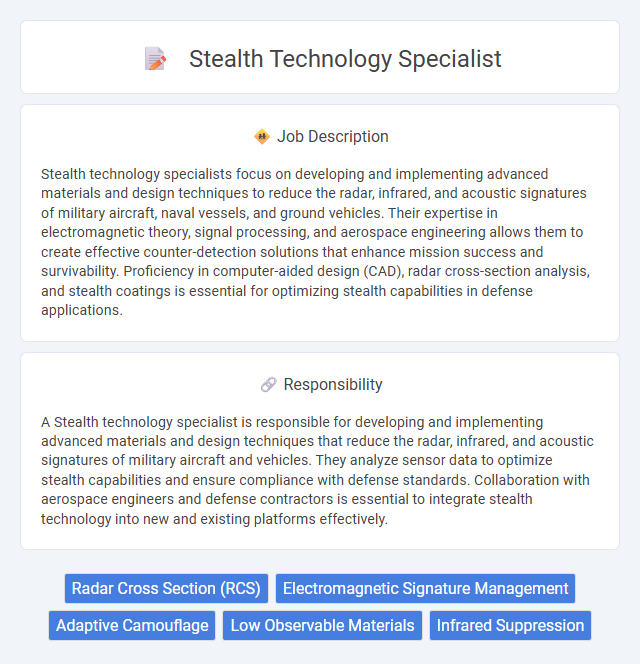
Stealth technology specialists focus on developing and implementing advanced materials and design techniques to reduce the radar, infrared, and acoustic signatures of military aircraft, naval vessels, and ground vehicles. Their expertise in electromagnetic theory, signal processing, and aerospace engineering allows them to create effective counter-detection solutions that enhance mission success and survivability. Proficiency in computer-aided design (CAD), radar cross-section analysis, and stealth coatings is essential for optimizing stealth capabilities in defense applications.
Individuals with strong analytical skills and a keen attention to detail are likely suitable for a Stealth technology specialist role, as the job demands precision and problem-solving abilities. Those comfortable working in high-security environments and handling complex, confidential information probably find the conditions manageable. People who thrive in structured, technology-driven settings may have a higher probability of succeeding in this specialized and highly technical field.
Qualification
A Stealth technology specialist must possess advanced knowledge in radar systems, electromagnetic theory, and materials science, with a strong background in aerospace or defense engineering. Proficiency in computer-aided design (CAD), signal processing, and simulation software is essential for developing and analyzing stealth capabilities. Candidates typically require a bachelor's or master's degree in engineering or physics, alongside experience in stealth technology research and compliance with military standards.
Responsibility
A Stealth technology specialist is responsible for developing and implementing advanced materials and design techniques that reduce the radar, infrared, and acoustic signatures of military aircraft and vehicles. They analyze sensor data to optimize stealth capabilities and ensure compliance with defense standards. Collaboration with aerospace engineers and defense contractors is essential to integrate stealth technology into new and existing platforms effectively.
Benefit
Stealth technology specialists might experience significant career benefits, including high demand in defense and aerospace sectors, which could lead to job stability and competitive salaries. They may also benefit from opportunities to work on innovative projects involving radar evasion and signal reduction techniques. Working in this field likely provides chances for professional growth and involvement in cutting-edge technology development.
Challenge
Stealth technology specialists likely face complex challenges involving the design and integration of advanced materials and systems to reduce radar and infrared detection. The role probably requires continuous adaptation to emerging detection technologies, demanding innovative problem-solving and extensive testing. Working in this field may necessitate balancing operational stealth effectiveness with practical constraints like cost and durability.
Career Advancement
Stealth technology specialists drive innovation in radar-evading materials and designs, enhancing national defense capabilities. Mastery in electromagnetic wave absorption and advanced composite engineering opens pathways to leadership roles in aerospace and defense firms. Continuous skill development in signal processing and system integration propels career growth toward senior engineering and strategic project management positions.
Key Terms
Radar Cross Section (RCS)
Stealth technology specialists focus on minimizing Radar Cross Section (RCS) to reduce the detectability of aircraft and vehicles by radar systems. They employ advanced materials, surface shaping, and electromagnetic wave absorption techniques to control radar signal reflection and scattering. Expertise in computational electromagnetics and RCS measurement tools is essential for optimizing stealth designs and enhancing operational effectiveness.
Electromagnetic Signature Management
A Stealth Technology Specialist specializing in Electromagnetic Signature Management develops and implements advanced techniques to reduce or mask electromagnetic emissions from military vehicles and aircraft, enhancing their survivability against radar and detection systems. They analyze radar cross-section data and employ materials engineering, signal modulation, and emission control strategies to minimize detectability in complex threat environments. Expertise in electromagnetic compatibility, stealth coatings, and active countermeasures is critical for optimizing stealth capabilities and ensuring mission success.
Adaptive Camouflage
A Stealth Technology Specialist focusing on Adaptive Camouflage designs and implements advanced materials and surfaces that dynamically change to match surrounding environments, enhancing invisibility to enemy sensors. Expertise in electromagnetic spectrum manipulation, including infrared and radar signature reduction, is critical in developing cutting-edge adaptive coatings and metamaterials. Proficiency in optical engineering, signal processing, and real-time environment sensing enables the creation of responsive camouflage systems used in military aircraft, vehicles, and personnel gear to minimize detection and improve survivability.
Low Observable Materials
Stealth technology specialists concentrate on low observable materials that reduce radar, infrared, and acoustic signatures to enhance the survivability of military assets. Expertise in advanced composites, radar-absorbing coatings, and metamaterials is essential to develop solutions that minimize detectability across multiple sensor spectrums. Proficiency in materials science, electromagnetic theory, and weapon system integration ensures effective application of low observable technologies for modern defense systems.
Infrared Suppression
A Stealth Technology Specialist focusing on Infrared Suppression engineers advanced materials and coatings to reduce heat signatures of military platforms, enhancing concealment from IR detection systems. Expertise in thermal management and sensor countermeasures enables the design of active and passive infrared suppression systems, critical for aircraft, naval vessels, and ground vehicles. Proficiency in infrared signature modeling and real-time thermal imaging analysis supports the development of cutting-edge stealth capabilities that minimize detectability in hostile environments.
 kuljobs.com
kuljobs.com